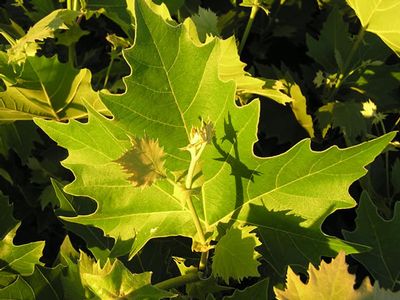London Plane Tree
Category: Deciduous Trees

Facts about London Plane Tree, "Scientific name for London Plane Tree is Platanus x acerifolia". London Plane Tree also known as hybrid plane tree is a large deciduous tree. It grows up to 100 feet (30 m) tall with the exceptional trees growing up to 130 feet (40 m) tall. The trunk is 10 feet (3 m) in circumference, pale grey in color, exfoliating and smooth or buff-brown in color and non-exfoliating.
The London Plane Tree grows well in average, medium to wet, well drained soils. Full sun is suitable for its proper growth though it can tolerate light shade.
The thick and broad leaves of the London Plane Tree have a stiff texture. The leaf blade is around 4 to 8 inches (10 to 20 cm) long and 4 3/4 to 10 inches (12 to 25 cm) broad with petioles which are 1 1/8 to 4 inches (3 to 10 cm) long. In summer, the young leaves are seen coated with fine, minute stiff hairs which wear off in late summer.
The London Plane Tree bores flowers that are arranged well in one stem to two stems. The male and female are on separate stems.
The fruit borne by the London Plane Tree matures in six months time. It is around 3/4 to 1 1/8 inches (2 to 3 cm) in diameter and has dense spherical clusters of dry achenes with stiff hairs to help aid wind dispersal. Later the cluster breaks up in winter and releases the seeds which are (2 to 3 mm) seeds.
London Plane Tree is very popular as an urban roadside tree. This is because the London Plane Tree is tolerant to pollution and root compaction. Again, it has a good tolerance of winter and wind. You will find out that it is widely planted around the world as an ornamental and parkland tree.
London Plane Tree growth is referred to as Meristem (The undifferentiated embryonic plant tissue from which new cells are created, as that at the tip of a root or stem). This tissue can be found at the tips of shoots and leaves. Inside the stem growth in thickness occurs at the vascular cambium.
London Plane Trees make their own food from sunlight, carbon dioxide, water, and nutrients from the soil.
Though the London Plane Tree is preferred in many urban places, the shedding of the young leaves and dispersing of the seeds is not very good for asthmatic people because if breathed in they can cause breathing difficulties. The leaves too can be a nuisance making the place untidy since it hard to dispose them.
Bark of the London Plane Tree protects it from the elements and is made up of dead cells.
London Plane Tree roots usually grow two to three times the width of the tree branches. The ideal time to fertilize your London Plane Tree is in late fall or early spring. If you want to transplant a tree do it in fall, this is ideal for most trees.
The London Plane Tree has a very decorative and attractive timber when quarter-sawn. It’s normally dark-reddish with a lighter background and it’s known as lacewood.
A Full grown London Plane Tree can absorb as much as 48 pounds (21.77 kg) of carbon dioxide a year. The same tree could also produce enough oxygen in a day for two people. In a single day, a large London Plane Tree can drink up to 100 gallons (378.5 liter) of water from the ground and discharge it into the air.
You can tell a London Plane Tree age by the number of growth rings. Growth rings size shows what kind of conditions accrued that year, the temperature and if it was a dry or wet year.
London Plane Tree leaves are made up of many colored pigments, green chlorophyll hides the colors during the growing season of spring and summer. As days get Shorter and cooler temperatures come in the fall, it cause the chlorophyll to break down and than the other color pigments can be seen.

 Back To Category Deciduous Trees
Back To Category Deciduous Trees